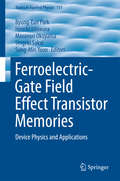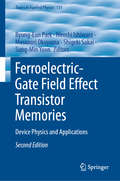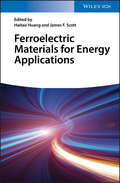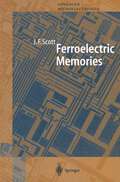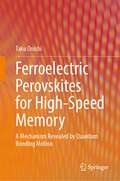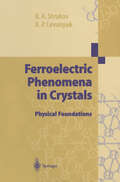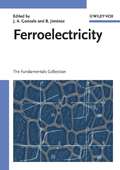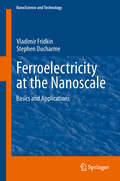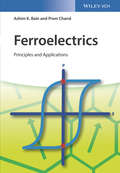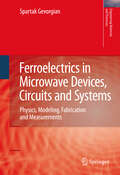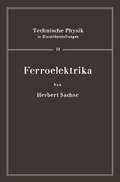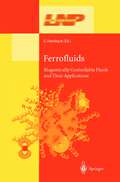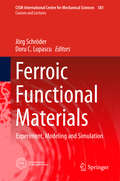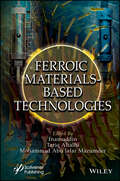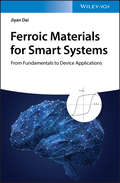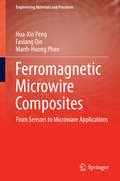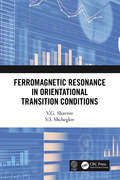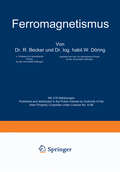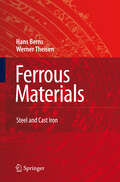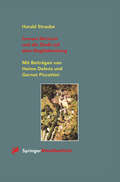- Table View
- List View
Ferroelectric-Gate Field Effect Transistor Memories: Device Physics and Applications (Topics in Applied Physics #131)
by Byung-Eun Park Hiroshi Ishiwara Masanori Okuyama Shigeki Sakai Sung-Min YoonThis book provides comprehensive coverage of the materials characteristics, process technologies, and device operations for memory field-effect transistors employing inorganic or organic ferroelectric thin films. This transistor-type ferroelectric memory has interesting fundamental device physics and potentially large industrial impact. Among the various applications of ferroelectric thin films, the development of nonvolatile ferroelectric random access memory (FeRAM) has progressed most actively since the late 1980s and has achieved modest mass production levels for specific applications since 1995. There are two types of memory cells in ferroelectric nonvolatile memories. One is the capacitor-type FeRAM and the other is the field-effect transistor (FET)-type FeRAM. Although the FET-type FeRAM claims ultimate scalability and nondestructive readout characteristics, the capacitor-type FeRAMs have been the main interest for the major semiconductor memory companies, because the ferroelectric FET has fatal handicaps of cross-talk for random accessibility and short retention time. This book aims to provide readers with the development history, technical issues, fabrication methodologies, and promising applications of FET-type ferroelectric memory devices, presenting a comprehensive review of past, present, and future technologies. The topics discussed will lead to further advances in large-area electronics implemented on glass or plastic substrates as well as in conventional Si electronics. The book is composed of chapters written by leading researchers in ferroelectric materials and related device technologies, including oxide and organic ferroelectric thin films.
Ferroelectric-Gate Field Effect Transistor Memories: Device Physics and Applications (Topics in Applied Physics #131)
by Byung-Eun Park Hiroshi Ishiwara Masanori Okuyama Shigeki Sakai Sung-Min YoonThis book provides comprehensive coverage of the materials characteristics, process technologies, and device operations for memory field-effect transistors employing inorganic or organic ferroelectric thin films. This transistor-type ferroelectric memory has interesting fundamental device physics and potentially large industrial impact. Among various applications of ferroelectric thin films, the development of nonvolatile ferroelectric random access memory (FeRAM) has been most actively progressed since the late 1980s and reached modest mass production for specific application since 1995. There are two types of memory cells in ferroelectric nonvolatile memories. One is the capacitor-type FeRAM and the other is the field-effect transistor (FET)-type FeRAM. Although the FET-type FeRAM claims the ultimate scalability and nondestructive readout characteristics, the capacitor-type FeRAMs have been the main interest for the major semiconductor memory companies, because the ferroelectric FET has fatal handicaps of cross-talk for random accessibility and short retention time. This book aims to provide the readers with development history, technical issues, fabrication methodologies, and promising applications of FET-type ferroelectric memory devices, presenting a comprehensive review of past, present, and future technologies. The topics discussed will lead to further advances in large-area electronics implemented on glass, plastic or paper substrates as well as in conventional Si electronics. The book is composed of chapters written by leading researchers in ferroelectric materials and related device technologies, including oxide and organic ferroelectric thin films.
Ferroelectric Materials for Energy Applications
by Haitao Huang James F. ScottProvides a comprehensive overview of the emerging applications of ferroelectric materials in energy harvesting and storage Conventional ferroelectric materials are normally used in sensors and actuators, memory devices, and field effect transistors, etc. Recent progress in this area showed that ferroelectric materials can harvest energy from multiple sources including mechanical energy, thermal fluctuations, and light. This book gives a complete summary of the novel energy-related applications of ferroelectric materials?and reviews both the recent advances as well as the future perspectives in this field. Beginning with the fundamentals of ferroelectric materials, Ferroelectric Materials for Energy Applications offers in-depth chapter coverage of: piezoelectric energy generation; ferroelectric photovoltaics; organic-inorganic hybrid perovskites for solar energy conversion; ferroelectric ceramics and thin films in electric energy storage; ferroelectric polymer composites in electric energy storage; pyroelectric energy harvesting; ferroelectrics in electrocaloric cooling; ferroelectric in photocatalysis; and first-principles calculations on ferroelectrics for energy applications. -Covers a highly application-oriented subject with great potential for energy conversion and storage applications. -Focused toward a large, interdisciplinary group consisting of material scientists, solid state physicists, engineering scientists, and industrial researchers -Edited by the "father of integrated ferroelectrics" Ferroelectric Materials for Energy Applications is an excellent book for researchers working on ferroelectric materials and energy materials, as well as engineers looking to broaden their view of the field.
Ferroelectric Materials for Energy Applications
by Haitao Huang James F. ScottProvides a comprehensive overview of the emerging applications of ferroelectric materials in energy harvesting and storage Conventional ferroelectric materials are normally used in sensors and actuators, memory devices, and field effect transistors, etc. Recent progress in this area showed that ferroelectric materials can harvest energy from multiple sources including mechanical energy, thermal fluctuations, and light. This book gives a complete summary of the novel energy-related applications of ferroelectric materials?and reviews both the recent advances as well as the future perspectives in this field. Beginning with the fundamentals of ferroelectric materials, Ferroelectric Materials for Energy Applications offers in-depth chapter coverage of: piezoelectric energy generation; ferroelectric photovoltaics; organic-inorganic hybrid perovskites for solar energy conversion; ferroelectric ceramics and thin films in electric energy storage; ferroelectric polymer composites in electric energy storage; pyroelectric energy harvesting; ferroelectrics in electrocaloric cooling; ferroelectric in photocatalysis; and first-principles calculations on ferroelectrics for energy applications. -Covers a highly application-oriented subject with great potential for energy conversion and storage applications. -Focused toward a large, interdisciplinary group consisting of material scientists, solid state physicists, engineering scientists, and industrial researchers -Edited by the "father of integrated ferroelectrics" Ferroelectric Materials for Energy Applications is an excellent book for researchers working on ferroelectric materials and energy materials, as well as engineers looking to broaden their view of the field.
Ferroelectric Memories (Springer Series in Advanced Microelectronics #3)
by James F. ScottThis is the first comprehensive book on ferroelectric memories which contains chapters on device design, processing, testing, and device physics, as well as on breakdown, leakage currents, switching mechanisms, and fatigue. State-of-the-art device designs are included and illustrated among the books many figures. More than 500 up-to-date references and 76 problems make it useful as a research reference for physicists, engineers and students.
Ferroelectric Perovskites for High-Speed Memory: A Mechanism Revealed by Quantum Bonding Motion
by Taku OnishiThis book is intended for theoretical and experimental researchers who are interested in ferroelectrics and advanced memory. After introducing readers to dielectric, perovskites, advanced memories, and ferroelectric, it explains quantum simulation. Then, using molecular orbital calculation results, it explains the ferroelectric mechanism in perovskite titanium oxides in concrete terms. Lastly, the book examines the materials designed for high-performance ferroelectrics and discusses the future of high-speed memory.
Ferroelectric Phenomena in Crystals: Physical Foundations
by Boris A. Strukov Arkadi P. LevanyukThe expansion of the application of ferroelectric crystals in engineering as well as of a number of fundamental problems of solid-state physics, which have not yet been solved and which bear a direct relation to ferro electricity, has lately stimulated much interest in the problem of ferroelectricity. In courses of solid-state physics ferroelectricity is studied today along with traditional disciplines, such as magnetism, superconductivity, and 'semiconducting phe nomena. Moreover, new specialities have been born concerned directly with the development and utilization of ferroelectric material~ in optics, acous tics, computer technology, and capacitor engineering. Special courses in the physics of ferroelectrics are read in a number of colleges and universities. The study of the nature of ferro electricity has currently reached such a level of development that we may speak of having gained a rather deep insight into the physical essence of a number of phenomena, which contribute to the generation of a spontaneous electric polarization in crystals. It is exactly at this level that it has become possible to single out that part of the problem, the physical picture of which can be depicted in a rather unsophisticated manner and which is the foundation for the construction of a building of "complete understanding".
Ferroelectricity: The Fundamentals Collection
by Julio A. Gonzalo Basilio JiménezThis indispensable collection of seminal papers on ferroelectricity provides an overview over almost a hundred years of basic and applied research. Containing historic contributions from renowned authors, this book presents developments in an area of science that is still rapidly growing. Although primarily aimed at scientists and academics involved in research, this will also be of use to students as well as newcomers to the field.
Ferroelectricity at the Nanoscale: Basics and Applications (NanoScience and Technology)
by Vladimir Fridkin Stephen DucharmeThe investigation of nanosized ferroelectric films and ferroelectric nanocrystals has attracted much attention during the past 15 – 20 years. There is interest in the fundamental and applied aspects. The theoretical basis is connected with the development of the Landau-Ginzburg-Devonshire (LGD) mean field and the first principles theories to the ultrathin ferroelectric films with thickness in the vicinity of critical size. Important potential applications are possible nanosize ferroelectric films in non-volatile memories, microelectronics, sensors, pyroelectric and electro-optic devices. This new area of research of ferroelectricity is still in impetuous development and far from completion. Many topics elucidated need generalization. The book contains theory and experimental data for a wide range of ferroelectric materials.
Ferroelectrics: Principles and Applications
by Ashim Kumar Bain Prem ChandCombining both fundamental principles and real-life applications in a single volume, this book discusses the latest research results in ferroelectrics, including many new ferroelectric materials for the latest technologies, such as capacitors, transducers and memories. The first two chapters introduce dielectrics and microscopic materials properties, while the following chapter discusses pyroelectricity and piezoelectricity. The larger part of the text is devoted to ferroelectricity and ferroelectric ceramics, with not only their fundamentals but also applications discussed. The book concludes with a look at the future for laser printed materials and applications. With over 600 references to recent publications on piezoelectric and ferroelectric materials, this is an invaluable reference for physicists, materials scientists and engineers.
Ferroelectrics: Principles and Applications
by Ashim Kumar Bain Prem ChandCombining both fundamental principles and real-life applications in a single volume, this book discusses the latest research results in ferroelectrics, including many new ferroelectric materials for the latest technologies, such as capacitors, transducers and memories. The first two chapters introduce dielectrics and microscopic materials properties, while the following chapter discusses pyroelectricity and piezoelectricity. The larger part of the text is devoted to ferroelectricity and ferroelectric ceramics, with not only their fundamentals but also applications discussed. The book concludes with a look at the future for laser printed materials and applications. With over 600 references to recent publications on piezoelectric and ferroelectric materials, this is an invaluable reference for physicists, materials scientists and engineers.
Ferroelectrics in Microwave Devices, Circuits and Systems: Physics, Modeling, Fabrication and Measurements (Engineering Materials and Processes)
by Spartak GevorgianToday’s wireless communications and information systems are heavily based on microwave technology. Current trends indicate that in the future along with - crowaves, the millimeter wave and Terahertz technologies will be used to meet the growing bandwidth and overall performance requirements. Moreover, motivated by the needs of the society, new industry sectors are gaining ground; such as wi- less sensor networks, safety and security systems, automotive, medical, envir- mental/food monitoring, radio tags etc. Furthermore, the progress and the pr- lems in the modern society indicate that in the future these systems have to be more user/consumer friendly, i. e. adaptable, reconfigurable and cost effective. The mobile phone is a typical example which today is much more than just a phone; it includes a range of new functionalities such as Internet, GPS, TV, etc. To handle, in a cost effective way, all available and new future standards, the growing n- ber of the channels and bandwidth both the mobile handsets and the associated systems have to be agile (adaptable/reconfigurable). The complex societal needs have initiated considerable activities in the field of cognitive and software defined radios and triggered extensive research in adequate components and technology platforms. To meet the stringent requirements of these systems, especially in ag- ity and cost, new components with enhanced performances and new functionalities are needed. In this sense the components based on ferroelectrics have greater - tential and already are gaining ground.
Ferrofluids: Magnetically Controllable Fluids and Their Applications (Lecture Notes in Physics #594)
by Stefan OdenbachMagnetic control of the properties and the flow of liquids is a challenging field for basic research and for applications. This book is meant to be both an introduction to, and a state-of-the-art review of, this topic. Written in the form of a set of lectures and tutorial reviews, the book addresses the synthesis and characterization of magnetic fluids, their hydrodynamical description and their rheological properties. The book closes with an account of magnetic drug targeting.
Ferroic Functional Materials: Experiment, Modeling and Simulation (CISM International Centre for Mechanical Sciences #581)
by Jörg Schröder Doru C. LupascuThe book covers experiments and theory in the fields of ferroelectrics, ferromagnets, ferroelastics, and multiferroics. Topics include experimental preparation and characterization of magnetoelectric multiferroics, the modeling of ferroelectric and ferromagnetic materials, the formation of ferroic microstructures and their continuum-mechanical modeling, computational homogenization, and the algorithmic treatment in the framework of numerical solution strategies.
Ferroic Materials-Based Technologies
by Inamuddin Tariq Altalhi Mohammad Abu Jafar MazumderFERROIC MATERIALS-BASED TECHNOLOGIES The book addresses the prospective, relevant, and original research developments in the ferroelectric, magnetic, and multiferroic fields. Ferroic materials have sparked widespread attention because they represent a broad spectrum of elementary physics and are employed in a plethora of fields, including flexible memory, enormous energy harvesting/storage, spintronic functionalities, spin caloritronics, and a large range of other multi-functional devices. With the application of new ferroic materials, strong room-temperature ferroelectricity with high saturation polarization may be established in ferroelectric materials, and magnetism with significant magnetization can be accomplished in magnetic materials. Furthermore, magnetoelectric interaction between ferroelectric and magnetic orderings is high in multiferroic materials, which could enable a wide range of innovative devices. Magnetic, ferroelectric, and multiferroic 2D materials with ultrathin characteristics above ambient temperature are often expected to enable future miniaturization of electronics beyond Moore’s law for energy-efficient nanodevices. This book addresses the prospective, relevant, and original research developments in the ferroelectric, magnetic, and multiferroic fields. Audience The book will interest materials scientists, physicists, and engineers working in ferroic and multiferroic materials.
Ferroic Materials-Based Technologies
by Inamuddin Tariq Altalhi Mohammad Abu Jafar MazumderFERROIC MATERIALS-BASED TECHNOLOGIES The book addresses the prospective, relevant, and original research developments in the ferroelectric, magnetic, and multiferroic fields. Ferroic materials have sparked widespread attention because they represent a broad spectrum of elementary physics and are employed in a plethora of fields, including flexible memory, enormous energy harvesting/storage, spintronic functionalities, spin caloritronics, and a large range of other multi-functional devices. With the application of new ferroic materials, strong room-temperature ferroelectricity with high saturation polarization may be established in ferroelectric materials, and magnetism with significant magnetization can be accomplished in magnetic materials. Furthermore, magnetoelectric interaction between ferroelectric and magnetic orderings is high in multiferroic materials, which could enable a wide range of innovative devices. Magnetic, ferroelectric, and multiferroic 2D materials with ultrathin characteristics above ambient temperature are often expected to enable future miniaturization of electronics beyond Moore’s law for energy-efficient nanodevices. This book addresses the prospective, relevant, and original research developments in the ferroelectric, magnetic, and multiferroic fields. Audience The book will interest materials scientists, physicists, and engineers working in ferroic and multiferroic materials.
Ferroic Materials for Smart Systems: From Fundamentals to Device Applications
by Jiyan DaiPresents state-of-the-art knowledge?from basic insights to applications?on ferroic materials-based devices This book covers the fundamental physics, fabrication methods, and applications of ferroic materials and covers bulk, thin films, and nanomaterials. It provides a thorough overview of smart materials and systems involving the interplays among the mechanical strain, electrical polarization, magnetization, as well as heat and light. Materials presented include ferroelectric, multiferroic, piezoelectric, electrostrictive, magnetostrictive, and shape memory materials as well as their composites. The book also introduces various sensor and transducer applications, such as ultrasonic transducers, surface acoustic wave devices, microwave devices, magneto-electric devices, infrared detectors and memories. Ferroic Materials for Smart Systems: Fabrication, Devices and Applications introduces advanced measurement and testing techniques in ferroelectrics, including FeRAM and ferroelectric tunnelling based resistive switching. It also looks at ferroelectricity in emerging materials, such as 2D materials and high-k gate dielectric material HfO2. Engineering considerations for device design and fabrication are examined, as well as applications for magnetostrictive devices. Multiferroics of materials possessing both ferromagnetic and ferroelectric orders is covered, along with ferroelastic materials represented by shape memory alloy and magnetic shape memory alloys. -Brings together physics, fabrication, and applications of ferroic materials in a coherent manner -Discusses recent advances in ferroic materials technology and applications -Covers dielectric, ferroelectric, pyroelectric and piezoelectric materials -Introduces electrostrictive materials and magnetostrictive materials -Examines shape memory alloys and magneto-shape-memory alloys -Introduces devices based on the integration of ferroelectric and ferromagnetic materials such as multiferroic memory device and ME coupling device for sensor applications Ferroic Materials for Smart Systems: Fabrication, Devices and Applications will appeal to a wide variety of researchers and developers in physics, materials science and engineering.
Ferroic Materials for Smart Systems: From Fundamentals to Device Applications
by Jiyan DaiPresents state-of-the-art knowledge?from basic insights to applications?on ferroic materials-based devices This book covers the fundamental physics, fabrication methods, and applications of ferroic materials and covers bulk, thin films, and nanomaterials. It provides a thorough overview of smart materials and systems involving the interplays among the mechanical strain, electrical polarization, magnetization, as well as heat and light. Materials presented include ferroelectric, multiferroic, piezoelectric, electrostrictive, magnetostrictive, and shape memory materials as well as their composites. The book also introduces various sensor and transducer applications, such as ultrasonic transducers, surface acoustic wave devices, microwave devices, magneto-electric devices, infrared detectors and memories. Ferroic Materials for Smart Systems: Fabrication, Devices and Applications introduces advanced measurement and testing techniques in ferroelectrics, including FeRAM and ferroelectric tunnelling based resistive switching. It also looks at ferroelectricity in emerging materials, such as 2D materials and high-k gate dielectric material HfO2. Engineering considerations for device design and fabrication are examined, as well as applications for magnetostrictive devices. Multiferroics of materials possessing both ferromagnetic and ferroelectric orders is covered, along with ferroelastic materials represented by shape memory alloy and magnetic shape memory alloys. -Brings together physics, fabrication, and applications of ferroic materials in a coherent manner -Discusses recent advances in ferroic materials technology and applications -Covers dielectric, ferroelectric, pyroelectric and piezoelectric materials -Introduces electrostrictive materials and magnetostrictive materials -Examines shape memory alloys and magneto-shape-memory alloys -Introduces devices based on the integration of ferroelectric and ferromagnetic materials such as multiferroic memory device and ME coupling device for sensor applications Ferroic Materials for Smart Systems: Fabrication, Devices and Applications will appeal to a wide variety of researchers and developers in physics, materials science and engineering.
Ferromagnetic Microwire Composites: From Sensors to Microwave Applications (Engineering Materials and Processes)
by Hua-Xin Peng Faxiang Qin Manh-Huong PhanSituated at the forefront of interdisciplinary research on ferromagnetic microwires and their multifunctional composites, this book starts with a comprehensive treatment of the processing, structure, properties and applications of magnetic microwires. Special emphasis is placed on the giant magnetoimpedance (GMI) effect, which forms the basis for developing high-performance magnetic sensors. After defining the key criteria for selecting microwires for various types of GMI sensors, the book illustrates how ferromagnetic microwires are employed as functional fillers to create a new class of composite materials with multiple functionalities for sensing and microwave applications. Readers are introduced to state-of-the-art fabrication methods, microwave tunable properties, microwave absorption and shielding behaviours, as well as the metamaterial characteristics of these newly developed ferromagnetic microwire composites. Lastly, potential engineering applications are proposed so as to highlight the most promising perspectives, current challenges and possible solutions.
Ferromagnetic Resonance in Orientational Transition Conditions
by V.G. Shavrov V.I. ShcheglovThe unique properties of ferromagnetic resonance (FMR) in magnetodielectric solids are widely used to create highly efficient analog information processing devices in the microwave range. Such devices include filters, delay lines, phase shifters, non-reciprocal and non-linear devices, and others. This book examines magnetic resonance and ferromagnetic resonance under a wide variety of conditions to study physical properties of magnetodielectric materials. The authors explore the properties in various mediums that significantly complicate magnetic resonance and provide a summary of related advances obtained during the last two decades. It also covers the emergence of new branches of the spectrum and anomalous dependencies on the magnetic field. Key Features: Reviews basic principles of the science of crystallographic symmetry and anisotropic solid-state properties Addresses the inhomogeneous nature of the distribution of the magnetization in the material being studied Explains the mathematic methods used in the calculation of anisotropic solids of a solid Provides the reader with a path to substitute electromagnetic waves when magnetostatic apparatus prove insufficient
Ferromagnetic Resonance in Orientational Transition Conditions
by V.G. Shavrov V.I. ShcheglovThe unique properties of ferromagnetic resonance (FMR) in magnetodielectric solids are widely used to create highly efficient analog information processing devices in the microwave range. Such devices include filters, delay lines, phase shifters, non-reciprocal and non-linear devices, and others. This book examines magnetic resonance and ferromagnetic resonance under a wide variety of conditions to study physical properties of magnetodielectric materials. The authors explore the properties in various mediums that significantly complicate magnetic resonance and provide a summary of related advances obtained during the last two decades. It also covers the emergence of new branches of the spectrum and anomalous dependencies on the magnetic field. Key Features: Reviews basic principles of the science of crystallographic symmetry and anisotropic solid-state properties Addresses the inhomogeneous nature of the distribution of the magnetization in the material being studied Explains the mathematic methods used in the calculation of anisotropic solids of a solid Provides the reader with a path to substitute electromagnetic waves when magnetostatic apparatus prove insufficient
Ferromagnetismus
by R. Becker W. DöringDieser Buchtitel ist Teil des Digitalisierungsprojekts Springer Book Archives mit Publikationen, die seit den Anfängen des Verlags von 1842 erschienen sind. Der Verlag stellt mit diesem Archiv Quellen für die historische wie auch die disziplingeschichtliche Forschung zur Verfügung, die jeweils im historischen Kontext betrachtet werden müssen. Dieser Titel erschien in der Zeit vor 1945 und wird daher in seiner zeittypischen politisch-ideologischen Ausrichtung vom Verlag nicht beworben.
Ferrous Materials: Steel and Cast Iron
by Hans Berns Werner TheisenFerrous materials have made a major contribution to the development of modern technology. They span a tremendous range of properties and applications. Part A of this book is dedicated to the fundamental relationships between the structure and the properties of ferrous materials. The considerably larger Part B deals with standardised materials, recent developments and industrial applications, which also affect processing aspects. Details are given for general engineering materials, tool and functional materials, as well as high-strength, creep-resistant and wear-resistant grades. This book closes the gap in the treatment of steel and cast iron. Each chapter takes into account the gradual transitions between the two types of ferrous materials. The authors demonstrate that steel and cast iron are versatile and customisable materials which will continue to play a key role in the future.
Ferrum Noricum und die Stadt auf dem Magdalensberg
by Harald StraubeSeit der Steinzeit ist die Geschichte des Menschen von der Suche nach geeigneten Werkstoffen für seine Werkzeuge und Gebrauchsgegenstände begleitet. Metallwerkstoffe haben dank ihrer Eigenschaften hervorragende Bedeutung. Das Buch beschreibt ihren Entwicklungsweg bis zu dem von den Römern hochgeschätzten Ferrum noricum, die Bedeutung der Stadt auf dem Magdalensberg in Kärnten als deren Umschlagplatz und bringt schwerpunktmäßig den durch Versuche und Funde belegten Nachweis über den Herstellungsgang dieses härtbaren kohlenstoffhaltigen Stahles. Die mit den detailliert beschriebenen thermodynamischen Grundlagen übereinstimmende Metallurgie des Rennofens unterscheidet sich deutlich von den bis vor kurzem bestehenden Vorstellungen. Die Ergebnisse führten zu einer nunmehr wesentlich sinnvolleren Neuübersetzung der einschlägigen Stellen aus der naturalis historia von Plinius. Jüngste Untersuchungen konnten zur Klärung bisher widersprüchlicher Fundergebnisse beitragen. Ziel des Buches ist es auch, den Archäologen und anderen Interessenten Einblick in die Metallurgie des Rennofens zu gewähren und immer noch bestehende irrige Ansichten zu widerlegen.
